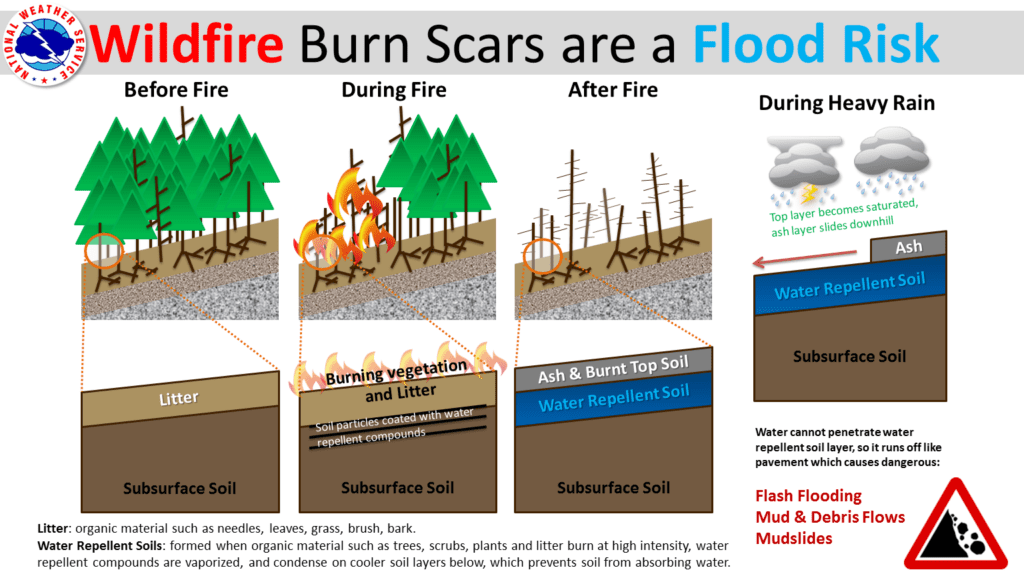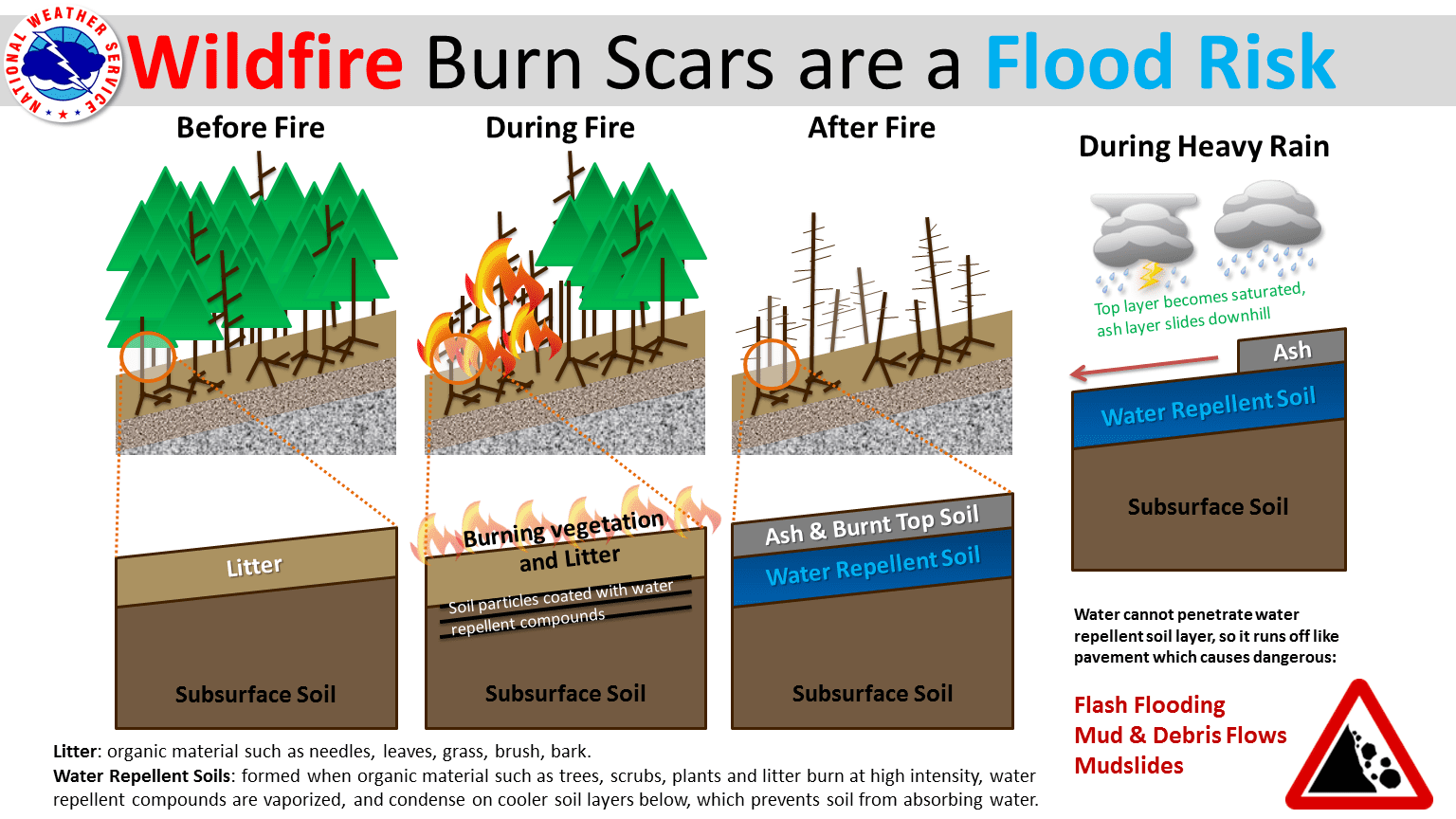The recent wildfires and their effects on the landscape can lead to an increased risk of flooding, particularly flash flooding and debris flows, in the affected areas. National Weather Service (NWS) has also published article “Flood After Fire – Burned Areas Have an Increased Risk of Flash Flooding and Debris Flows” to prioritize public safety and awareness. Lets understand the key perspective behind Why Floods Often Follow Fires and how to keep your family safe during these floods.

Why Floods Often Follow Fires?
Impact of Wildfires:
- Wildfires can have long-lasting effects on the landscape. The heat and duration of the fire can create conditions that change the way water interacts with the soil.
Risk of Flash Flooding and Debris Flows
- Locations downhill and downstream from areas that have been burned are at a high risk of flash flooding and debris flows, especially if the terrain is steep.
- In some areas where fires have burned intensely, soils may develop a layer that repels water, making it behave like rain on pavement. This means rainfall doesn’t get absorbed into the ground, leading to quicker runoff.
- The loss of plant material due to the fire contributes to the increased potential for debris flows since vegetation usually helps hold soil in place.
Identifying the Risk
- A general rule of thumb is that if you can look uphill from your location and see a burnt-out area, you are at risk of flash flooding and debris flows.
What is Debris Flows?
- Debris flows are fast-moving and dangerous landslides that consist of a mixture of mud, rocks, boulders, trees, and sometimes even homes or vehicles.
- While people often use terms like “mudslides” or “mudflows” interchangeably, to scientists, each of these is a distinct type of landslide, and debris flows are considered the most powerful and hazardous.
What Causes Debris Flows?
- Debris flows most commonly occur during intense rainfall following wildfires.
- A debris flow can start on a dry slope after only a few minutes of intense rain, which means it doesn’t require a long period of rain or a saturated slope.
- The intensity of the rain, specifically the rainfall rate, is more important than the total amount of rainfall in triggering debris flows.
Why Debris Flows Are Dangerous?
- Debris flows are fast and unpredictable, often moving faster than a person can run or even catch up to a car.
- The starting point and path of a debris flow are challenging to predict. It can start in a stream channel and then suddenly shift and spread through a neighborhood.
- Debris flows may occur in areas with a history of such events or in entirely new locations that have never experienced them before.
Combination of wildfires, altered soil conditions, and intense rainfall can lead to the dangerous phenomenon of debris flows, which are fast-moving and unpredictable landslides consisting of various materials. It’s crucial to be aware of the increased risk in areas affected by wildfires and to take appropriate precautions to stay safe during and after intense rain events. Also Read: Canada Wildfires : How to Keep Your Family Safe Amidst this Environmental Challenge
How to Keep Your Family Safe During Flood
Before the Flood
- Have a Plan:
- Be prepared to react quickly to flash flooding or debris flows. Keep in mind that these events can be triggered by relatively small amounts of rain.
- Plan your evacuation route in advance. If time permits, use this route to reach safety. Climbing uphill may be your best option in some cases.
- Monitor the Weather:
- Stay informed about the weather conditions. Flash floods and debris flows can happen swiftly.
- Have multiple ways to receive weather warnings. Consider NOAA Weather Radio with Tone Alert and SAME features.
- Follow official sources for updates on social media, like NWS Boulder on Twitter or Facebook.
- Sign up for emergency alerts with your county or local Emergency Management Agency. Visit State emergency management agencies to get the details of Emergency Management Agency near by you.
- Prepare an Emergency Kit:
- Create an emergency kit with essential supplies.
- Plan evacuation routes and ensure that important documents are stored in a safe and waterproof location.
- Flood Insurance:
- Consider purchasing flood insurance. Note that it takes 30 days to go into effect.
- Familiarize yourself with your current insurance policy to understand what it covers and ensure the limits provide adequate protection for your property and belongings.
- Document Your Possessions:
- Itemize and take pictures of your belongings for insurance and recovery purposes.
- Additional flood safety information may be available for reference.
During the Flood:
- Stay Alert:
- Continuously monitor the weather, especially during storms that could lead to landslides. Many landslide-related deaths occur when people are asleep.
- Watch for Environmental Cues:
- Pay attention to environmental signs that may indicate impending flash flooding or debris flows. This includes observing storm clouds upstream of your location and changes in water levels in creeks, streams, and dry washes.
- Rapidly fluctuating water levels can be a sign of a debris blockage being released upstream.
- Be Prepared to Act Quickly:
- Recognize that in the case of a debris flow, the time between realization and danger is very short. Do not attempt to cross a road with flowing water or mud.
- Avoid crossing a bridge if you see a flow approaching, as it can grow rapidly, making escape impossible.
- If you find yourself in the path of a landslide, move uphill as rapidly as possible to seek safety.
Debris Flow Warning Signs:
- Pay attention to audible and visual indicators, which can include:
- Rushing water and mud.
- Unusual sounds, such as trees cracking or boulders colliding.
- A faint rumbling sound that increases in volume as the landslide approaches.
- Movement of objects like fences, retaining walls, utility poles, boulders, or trees.
It’s crucial to be well-prepared and vigilant in the face of flash flooding and debris flows, as timely action can make a significant difference in your safety and well-being during these events. Following these steps will ensure safety of you and your family during these events. Read article by NWS


